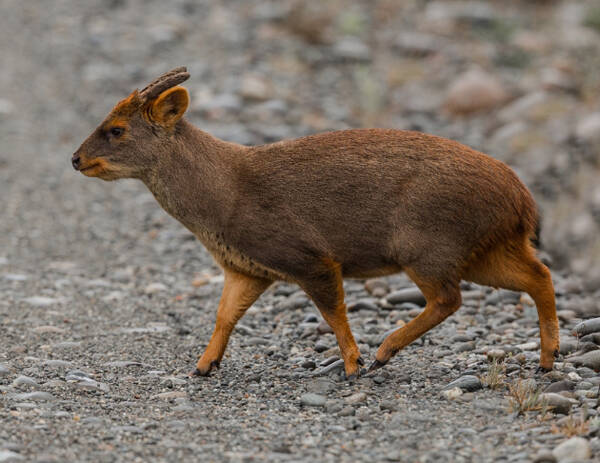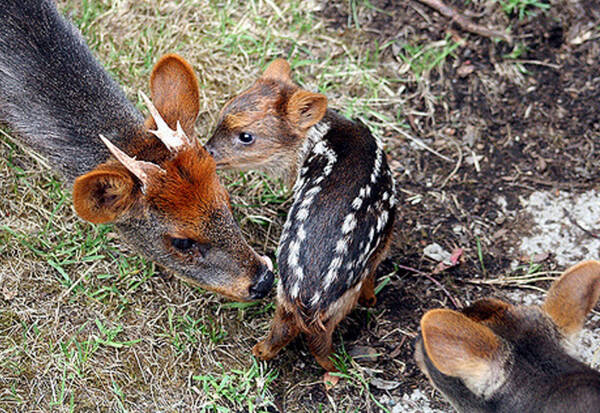Pudu puda
IUCN
LCBasic Information
Scientific classification
- name:Pudu puda
- Scientific Name:Pudu puda,Southern Pudu
- Outline:Ungulata
- Family:Artiodactyla Cervidae Purdue
Vital signs
- length:About 85 cm
- Weight:6.5-13.5kg
- lifetime:No verification information
Feature
The smallest deer in the world
Distribution and Habitat
Chilean deer are found in Chile and Argentina south of the Andes Mountains. They live in the mountains at an altitude of 2,000 meters, and can also be found in the lowlands along the coast. They prefer woodlands and forest environments that can provide a high degree of protection.
Appearance
The Chilean deer has a head and body length of 85 cm, a shoulder height of 35-45 cm, a tail length of 8 cm, horns of 7-10 cm, and a weight of 6.5 - 13.5 kg. It is small, round and stocky, with short legs. Its antlers are simple stems, 7-10 cm long, which fall off every year between July and August and grow back immediately. Their fur is smooth, ranging from reddish brown to dark brown, with lighter colors on the sides and lower limbs. The lips and the inside of the ears are orange-yellow. Their fur is thick and dense, which can protect them when moving through the forest. The ears are round and small, and the tail is also very short. The form is similar to many small forest ungulates, and is believed to be adapted and easier to pass through dense shrubs and bamboo thickets. Young deer have white spots, which may be used for camouflage.
Details
Chilean Pudu (scientific name: Pudu puda) is called Southern Pudu in foreign language. It is the smallest deer in the world and has no subspecies.

Chilean Pudu is a diurnal animal, but it is more active in the afternoon, evening and morning. It will go to open places to forage. The food is leaves, branches, bark, buds, fruits and seeds. Due to its small size, it often has to stand on its hind legs or jump onto fallen tree trunks to reach higher vegetation. It mainly feeds on the understory plants of moist forests, including ferns and leaves. Because its food is full of water, it rarely drinks water. This species has well-trampled trails throughout the year, with a feeding range of 1,626 hectares, and the habitat and rest areas are connected by paths through dense vegetation. Dung piles are usually formed next to these trails. They defecate in the same place and pile up dung piles, which may be used to mark territory.
The short but strong legs of the Chilean balearic deer allow them to walk on steep rocky slopes as if they were flat ground. When threatened, they will flee in a zigzag shape. Natural enemies include pumas, foxes, small cats and eagles.

Chilean deer are solitary animals that only gather during the breeding season, usually in April and May. The female's gestation period is usually from November to January each year, and a fawn will be born after about 7 months. The fawn is weaned at 2 months, and females reach sexual maturity at 3-6 months and males at 8-12. The offspring can remain with their mother for 8-12 months before becoming independent.
The population of the Chilean deer is declining due to habitat destruction caused by overgrazing and human development. The main threat to the Chilean deer is the destruction of temperate forest habitats throughout Chile, which are used for cattle ranching, logging and other human development. Habitat fragmentation and destruction through the conversion of forests to open land and exotic tree plantations has caused serious problems for the survival of the Chilean deer. Road traffic accidents and hunting are also responsible for the decline in populations. Hunters use hunting dogs to hunt wild Chilean deer. Other threats include the introduction of exotic species, such as red deer from Europe, which compete with the Chilean deer for food. Domestic dogs may also prey on the deer and may spread parasites, to which the Chilean deer are particularly susceptible.
Listed in the IUCN Red List of Threatened Species in 2016 ver 3.1 - Near Threatened (NT).
Protect wild animals and eliminate game.
Maintaining ecological balance is everyone's responsibility!








